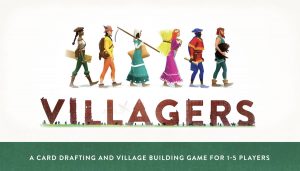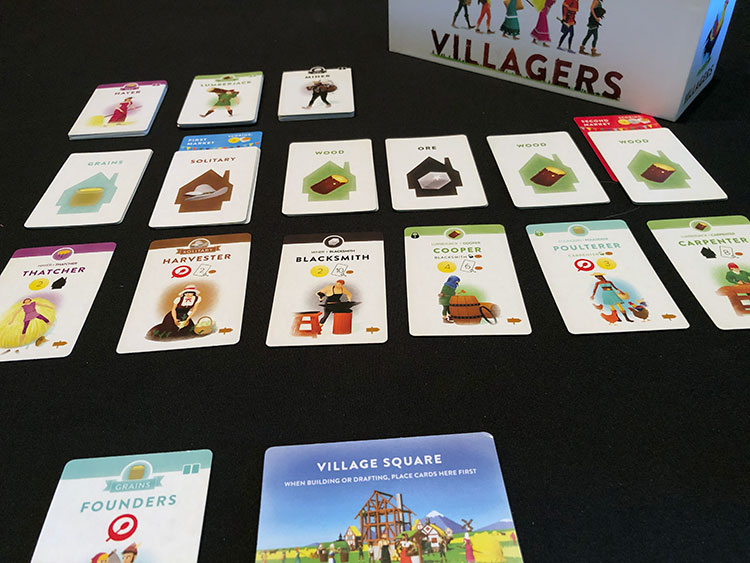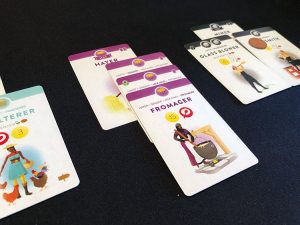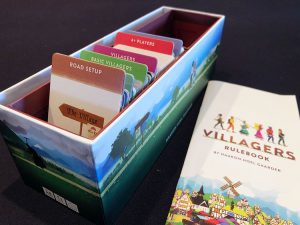 I remember first hearing about Villagers approximately two years ago. I read a review questioning if this game would be the next big thing. The game sounded interesting, but it was of a digital version based on a Print and Play copy, so I filed that into “look out for this in the future” and moved on. About a year later Tom Vasel reviewed the game and gave it the Dice Tower Seal of Approval. Unfortunately, Villagers was on Kickstarter and, by the time I watched the review, it was too late to back it. Stupid FOMO…
I remember first hearing about Villagers approximately two years ago. I read a review questioning if this game would be the next big thing. The game sounded interesting, but it was of a digital version based on a Print and Play copy, so I filed that into “look out for this in the future” and moved on. About a year later Tom Vasel reviewed the game and gave it the Dice Tower Seal of Approval. Unfortunately, Villagers was on Kickstarter and, by the time I watched the review, it was too late to back it. Stupid FOMO…
It appears patience is a virtue, as I was pleasantly surprised when the opportunity to review Villagers presented itself.
Random nature fact—an elephant’s gestation period is up to 22 months. Why am I telling you this? That is about how long I waited to play this game. Was the game worth the wait or was it a disappointment? Read on to find out!
Gameplay Overview:
Villagers is a card drafting, tableau-building game in which you are trying to rebuild a village after a great plague. In reality, the game is not that dark. You are simply building up a village from scratch.
The game is played over multiple rounds. A turn consists of two or three phases:
- Draft cards into your hand
- Build (play) cards from your hand into your tableau
- If triggered, there will be a market phase that is a scoring phase
- The First Market Phase happens when the second face-down stack is depleted
- The Second Market Phase triggers when the sixth face down stack is depleted
After the two (or three) phases are resolved, the first player card is passed clockwise, and the game continues until the Second Market Phase is triggered.
After the Second Market Phase, the player with the most Gold (points) will have built the most successful village and be declared the winner!

Game Experience:
I really enjoyed the design of Villagers. It was very easy to teach and played quickly with tough decisions, which is pretty much what I am looking for in most of my games. Leave Mage Knight alone…
The townspeople you are recruiting (drafting) for your village are grouped by production types, like suits in a standard deck of cards. There are nine suits in total and the back of a card indicates the villager’s suit, with cards of the same suit working together. For example, Ore includes Miners, Blacksmiths, and Jewelers.

Drafting in Villagers has two twists that make it unique compared to other drafting games. First, cards are drafted from either six face-up cards, called the Road, or from the face-down stacks above the Road. Second, players will not necessarily draft the same number of cards in a round. Players will draft two cards at a minimum but can draft up to five based on the number of Food icons their villagers provide.
The tableau-building has its own set of twists. Many villagers require basic villagers to be played; however, basic villagers are not drafted. They are played by exchanging a drafted card for the basic villager you want. A basic villager is placed in your village and can support up to two Production Chains, which is a chain of cards in which the previous card must be in the tableau before the next card can be played.
Finally, villager cards can have padlocks on them. This indicates a card needs to be unlocked for it to be played. For example, the Bed Builder requires a Carpenter. If you already have a Carpenter in play, the bank pays you two coins. If your opponent has one and you do not, you pay your opponent two coins and if no one has a Carpenter, you pay the bank two coins. Remember that coins equal points in this game, so establishing a self-sufficient village can benefit you as the bank pays your villager the coins!

Balancing what cards to draft and which villagers to play is the main decision point, and fun, of Villagers. There are only two copies of every villager in the game (three for the six starting villagers). Should you grab the blacksmith early so that players need to pay you to unlock their cards? Or do you start drafting cards to try to build a four chain and reap the benefits at the end? You have not yet seen a Spelunker, the third card in the four chain, but there is an Ore (its suit) in the facedown pile. Should you gamble and draft that card, or play it safe and wait? Another concern is balancing playing cards for points versus those with food icons or house icons (like drafting, you can only play two cards plus the number of house icons in your tableau, up to five cards, per turn).
Another thing I love is a twist on hate drafting, a common tactic in all drafting games where you draft a card your opponent needs. In Villagers, there is nothing you can do with a card other than play it, exchange it for a basic villager, or hold on to it. If it is late in the game and you need a basic villager, you may need to exchange that card you hate drafted, and then it will be back in play!

The only downside, and this was not a deal-breaker for me, is that the game is not very meaty. The retail version does not include any “first to x” bonus scoring opportunities or goals that might push you in a different direction. It is simply the six cards on the Road, build your village, and most points in the end wins.
In closing, there are two items I want to touch on. First, the box and the card dividers are brilliant and make set up and tear down a breeze. Second, there are two types of cards, Solitary (they do not require a basic villager to be played) and Special (rule-bending villagers) that add to the complexity, so it isn’t simply about building the biggest chains.
Final thoughts:
Drafting and tableau building are two of my favorite gaming mechanisms. I really wanted to play Villagers after hearing that it combined these in one game. Villagers surpassed my expectations, and I still look forward to playing it after 15+ games. The Production Chains and Unlocking really enhanced the tableau building. Even with the difficult decisions of which cards to draft and build, the game played faster than I thought it would. It was also easier to teach than I thought it would be. I 100% recommend playing this game if anything I have written has remotely interested you. It is an excellent game!
Final Score: 4 Stars – An excellent game that I highly recommend!
 Hits:
Hits:
• The core mechanisms, drafting and tableau building, are well designed and integrated
• Unlocking cards is a fun feature
• The perfect combination of difficult decisions and a brisk playtime
• Very easy to teach
• Excellent storage makes set up and tear down a breeze
Misses:
• Not the meatiest game I have played
























Hello, I am part of a gameschool FB group and we are researching games with diverse characters. These cards look quite diverse, but I can’t tell if the assigned roles reinforce stereotypical norms (ie: brown skin in low paying jobs, women in domestic jobs, men in hard labor, etc). Can you comment?
Hi Sarah, I can comment after looking through the cards in my own copy of Villagers.
I started looking at the cards featuring women: There are basic villagers in the game that can be acquired outside of the normal drafting. Those cards are double sided, with different art on each side. One is male, the other female. Those three jobs are lumberjack, miner, and hayer, none of which I associate with domestic jobs. Among the villagers that will be drafted, some may be considered domestic jobs for the time period (graper, fromager, beekeeper, milk maid as examples). But there are cards that feature women in non-domestic jobs, like wood carver, horse trader, wheeler, and wattler.
As for low paying jobs based on skin color, looking through the variety of jobs there aren’t many that one would consider high paying. Many of the jobs the villagers have are ones that are feature gathering crops or ore and turning them into their more-refined goods that are known to be sold (jewels, cheese, beer, etc.). It appears that it is a decent mix of people working different types of jobs.
Hope this answer is what you are looking for!
Hi Brian, excellent review! We’ve owned and enjoyed this game for a couple of months and there’s something that’s on my mind that you didn’t cover here. Why did the game designers include so much money in the bank? The highest score I’ve ever achieved is 292 and my partner scored 190 making a total all-player game score of 500ish. Yet there is upwards of 1,500 in the total bank. I just don’t see how it’s possible to collectively generate that much gold. Am I missing something?
Honestly, I never thought about it and you are 100% correct. I never came close either. That being said, I don’t think you are missing anything. Maybe it was done to allow making change easier at the end of the game so everyone had available money to work with?
You know that this can be played with up to 5 people right?